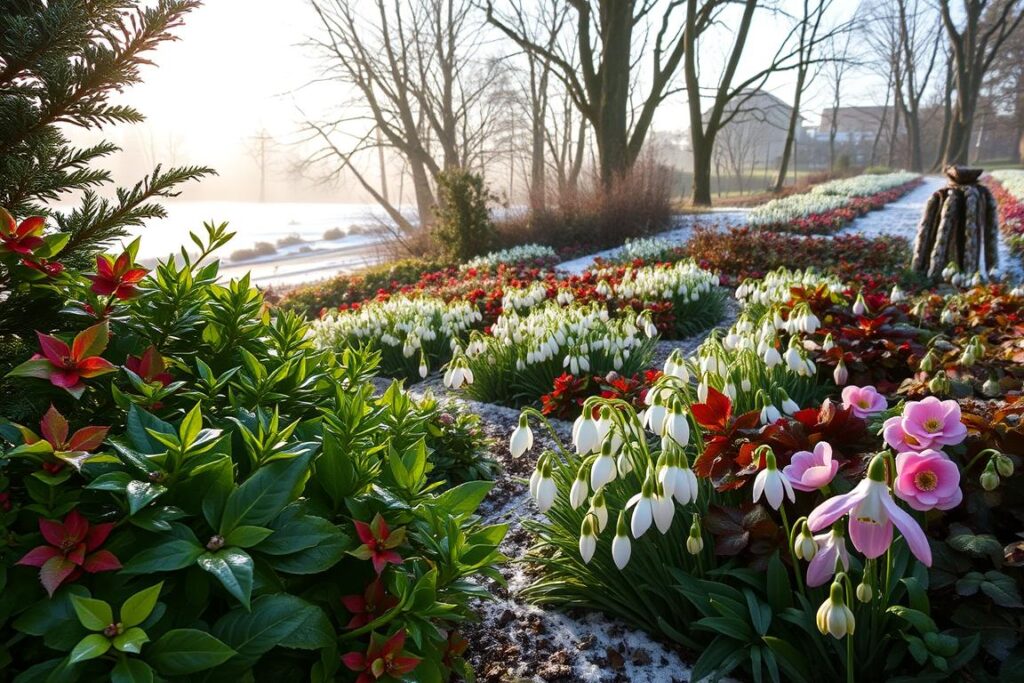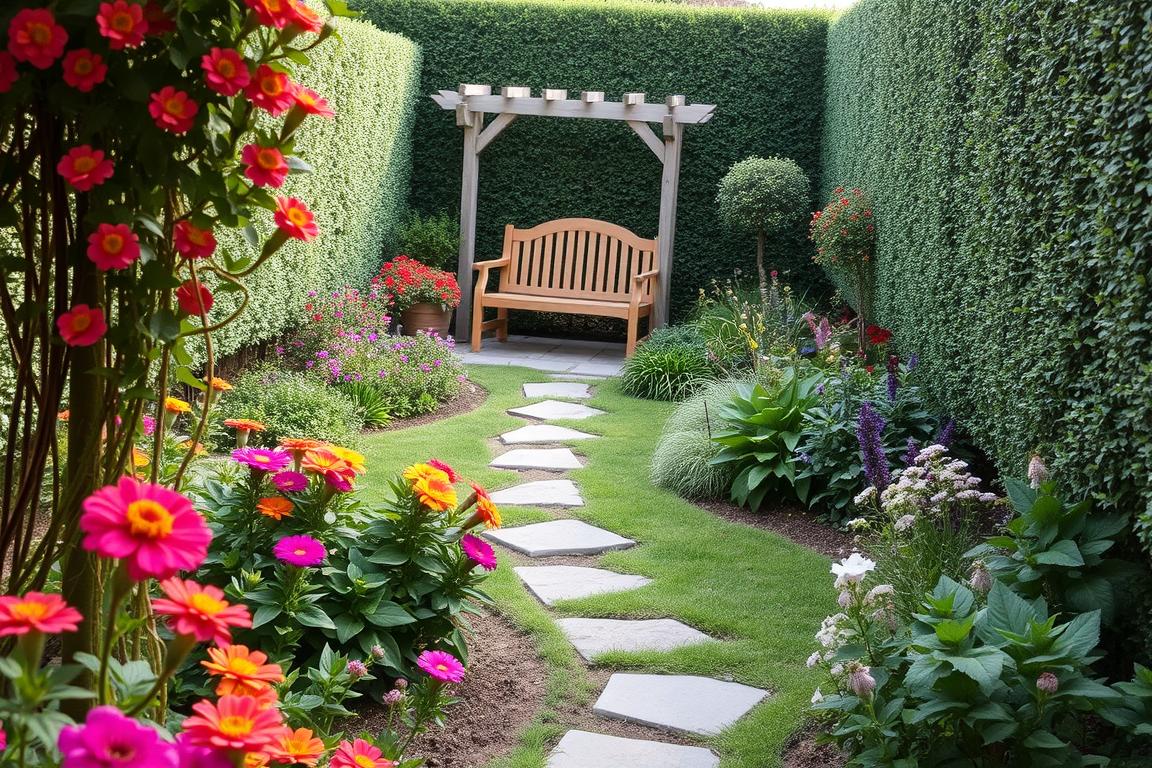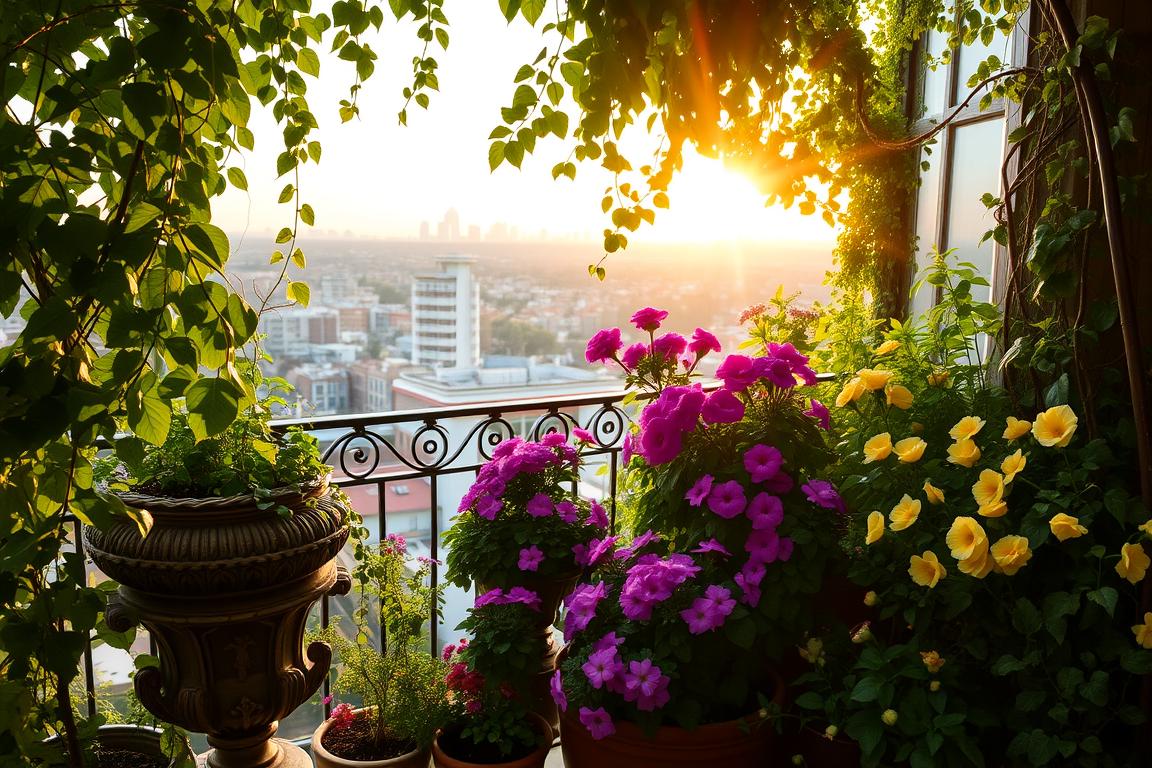As winter comes, you can make your garden bloom with the right plants. We’ll show you the top picks for a stunning winter garden. From plants that flower in winter to hardy shrubs, we’ve got you covered.
Choosing the right plants can make your garden vibrant and colorful, even in cold weather. Winter plants bring life to your outdoor space. They offer a mix of colors and textures that will impress.
Table of Contents
ToggleIntroduction to Winter Gardening
By picking the right plants, you can make your garden flourish in winter. Winter plants add beauty to your outdoor area. With the right choices, your garden will be beautiful all year.
Key Takeaways
- You can create a thriving and beautiful winter garden with the right plants.
- Winter garden plants are a great way to add some life to your outdoor space.
- The best plants for winter garden will provide you with a beautiful display of colors and textures.
- Winter gardening can be a great way to enjoy the outdoors even in the cold winter months.
- With the right selection of winter garden plants, you can flourish this winter.
Understanding Winter Garden Plants
When you think about a winter garden, knowing the right plants is key. Cold weather garden plants are made to handle frost, snow, and cold. They’re great for winter landscapes. Look for winter landscaping plants that are tough and can stand up to winter’s harshness.
Having a winter garden brings many benefits. It improves air quality, boosts your home’s look, and gives you a sense of pride. Plus, it creates a serene outdoor spot for the cold months. Here are some perks of a winter garden:
- Improved air quality
- Increased curb appeal
- A sense of accomplishment
- A beautiful and peaceful outdoor space
Next, we’ll look at different winter garden plants. We’ll cover perennials, annuals, and shrubs. This will help you start your own winter garden.
Selecting the Right Winter Plants
When planning your winter garden, picking the right plants is key. The United States has different climate zones. Each zone affects how well winter plants grow and survive.
It’s important to know your climate zone for the best winter plants. You can find your zone on a map or ask local nurseries. This helps you pick plants that will do well in your area.
When choosing winter plants, think about a few things:
- Soil type and drainage
- Sunlight and shade needs
- How well they handle cold
- How much water they need

By picking the right plants, you can make a beautiful winter garden. It will add color and joy to your outdoor space. Make sure to learn about each plant’s needs for the best results.
Popular Winter Flowering Plants
When planning your winter garden, think about adding some vibrant winter bloomers. Plants like pansies, violas, and cyclamen are great for this season.
These plants are not only stunning but also easy to care for. With the right care, they can bloom beautifully in the cold months. They add much-needed color to your garden. Some favorites include:
- Pansies, known for their bright colors and delicate petals
- Violas, which are smaller but just as beautiful
- Cyclamen, perfect for indoor gardens and low-light conditions
Adding these hardy winter plants to your garden makes it beautiful and thriving. They bring joy and color to your outdoor space all season long.
Hardy Shrubs for Winter Gardens
When planning your winter garden, think about adding hardy shrubs. Evergreen winter garden plants like winterberry holly, boxwood, and witch hazel are great choices. They are beautiful and easy to care for, perfect for those who are busy.
Consider what look you want for your garden. Do you prefer a neat, formal look or something more natural? Winter garden plants like boxwood can be shaped into topiaries. Winterberry holly and witch hazel add color and scent to your garden.

- Winterberry holly, known for its bright red berries
- Boxwood, a classic evergreen that can be shaped and trimmed
- Witch hazel, which produces unique and fragrant blooms in the winter
These shrubs add depth and interest to yourwinter garden plants. They can grow well in many conditions.
Adding hardy shrubs to your winter garden makes it beautiful and welcoming. It will attract birds, bees, and other wildlife. With the right care, these evergreen winter garden plants will bring joy for many years.
Winter Vegetables You Can Grow
Winter is not a time to stop gardening. It’s a chance to grow tasty and healthy winter garden plants. Kale and spinach are two great options that do well in cold weather.
Kale: A Nutrient Powerhouse
Kale is a superfood packed with vitamins and minerals. It’s easy to grow and ready to harvest in about 50 days. Plant kale in well-draining soil and give it full sun to partial shade.
Spinach: Cool-Weather Wonder
Spinach is another cool-weather favorite for winter gardens. It’s full of iron and ready in about 30 days. Plant spinach in well-draining soil and give it partial shade to full sun. Here are some tips for growing spinach:
- Plant spinach in the early spring or late summer/early fall
- Keep the soil consistently moist
- Fertilize spinach regularly for optimal growth
Winter Houseplants to Brighten Your Home
Exploring winter garden plants can brighten your home in the cold months. Adding best plants for winter garden indoors is a smart move. Christmas cactus and snake plant are excellent choices.
These plants add greenery with little effort. Think about your home’s light when picking plants. Snake plant works well in low light, while Christmas cactus brings color with its blooms.

- Temperature: Most plants like daytime temps of 65-75°F and cooler nights.
- Watering: Don’t overwater. Check soil moisture before watering.
- Humidity: Some plants need more moisture. A humidifier can help.
Choosing the right best plants for winter garden and following care tips will keep your plants thriving. Winter houseplants can make your home greener and brighter.
Planning Your Winter Garden Layout
Creating a beautiful winter garden starts with planning. You need to pick winter landscaping plants that do well in cold weather. Think about the colors, textures, and shapes of the plants to match your style.
A well-planned winter garden can be a peaceful spot, even in winter. Start by deciding on the style you like, whether it’s modern, traditional, or a mix. Think about the plants you want, like evergreen shrubs, flowering plants, or ornamental grasses.

Designing for Aesthetic Appeal
When designing your winter garden, keep these tips in mind:
- Color palette: Mix plants with different colors and textures for depth and interest.
- Plant height and shape: Choose plants of various heights and shapes for a beautiful landscape.
- Lighting: Add outdoor lighting to highlight your plants and create a cozy atmosphere.
Space Considerations
Remember to think about your garden’s space. Pick winter landscaping plants that are compact or dwarf. Use containers or raised beds to save space. With careful planning, you can have a stunning winter garden that thrives in cold weather.
Maintaining Your Winter Garden
To keep your winter garden plants thriving, it’s essential to provide them with the right care. This includes using proper watering techniques and fertilization tips. By doing so, you’ll be able to help your cold weather garden plants survive the harsh winter months and continue to flourish.
When it comes to watering your winter garden plants, it’s important to avoid overwatering. This can harm your plants, which are already stressed by the cold. Instead, water your plants sparingly, making sure the soil is moist but not waterlogged. You can also use mulch to help retain moisture in the soil and reduce the need for frequent watering.

In addition to proper watering techniques, fertilization is also vital for the health of your winter garden plants. You can use a balanced fertilizer to provide your plants with the necessary nutrients to grow and thrive. It’s also important to note that some winter garden plants, such as pansies and violas, may require more frequent fertilization than others.
Watering Techniques for Winter Gardens
- Water your plants sparingly, making sure the soil is moist but not waterlogged
- Use mulch to help retain moisture in the soil and reduce the need for frequent watering
- Avoid getting water on the leaves or crown of the plant to prevent rot and disease
Fertilization Tips for Cold Weather Garden Plants
- Use a balanced fertilizer to provide your plants with the necessary nutrients to grow and thrive
- Fertilize your plants regularly, following the instructions on the fertilizer package
- Consider using a fertilizer specially formulated for winter garden plants
By following these watering techniques and fertilization tips, you’ll be able to keep your winter garden plants healthy and thriving. Remember to always choose the right winter garden plants for your climate and provide them with the necessary care to ensure they continue to flourish throughout the winter months.
Creating Shelter for Winter Plants
As you care for your winter garden plants, it’s key to protect them from harsh weather. Creating shelter for your hardy winter plants is essential. This way, they can thrive and flourish even in the cold months.
Shelter is vital for the health and vitality of winter garden plants. Start by using cold frames and cloches to shield them from extreme temperatures and frost. These structures help control temperature and humidity, creating a good environment for growth.
Using Cold Frames and Cloches
Cold frames and cloches are great for protecting your winter garden plants. They trap warm air and moisture, keeping plants cozy and safe from the elements. You can cover individual plants or entire beds with them.

Selecting the Right Mulch
Along with cold frames and cloches, choosing the right mulch is important. Organic mulches like straw, bark chips, or leaves create a protective layer. They insulate the soil, reduce weeds, and prevent erosion.
By giving your winter garden plants the right shelter and care, you can have a vibrant garden even in the coldest months. Choose the right materials and techniques to protect your plants and help them flourish.
Gardening Tools for Winter Care
Getting ready for winter in your garden? The right tools are key for your plants’ health. For winter landscaping, the right tools can greatly improve your plants’ look and health.

Essential Tools for the Winter Gardener
Here are the must-haves for winter gardening:
- Gloves to protect your hands from the cold and any sharp objects
- Pruners to trim and shape your winter garden plants
- A garden fork to gently turn over the soil and remove any debris
These tools will help your winter garden plants stay healthy and look great all season.
Benefits of Using Quality Equipment
Quality equipment is a big plus for your winter garden. It makes gardening easier and keeps your plants safe. Good tools mean your winter garden will last for many years.
The Role of Soil in Winter Gardening
Soil is key for winter garden plants to grow and stay healthy. As winter approaches, think about your soil type. Cold weather garden plants need soil that drains well to avoid waterlogged conditions.
To get your soil ready for winter, add compost or manure. These improve drainage and aeration. Mulch also helps by keeping moisture in and weeds out, saving you from frequent watering.

The best soils for winter garden plants are sandy loam and clay loam. They drain well and let roots breathe. These soils are perfect for cold weather garden plants because they prevent waterlogging. With the right soil, your winter garden plants will thrive.
Here are some tips for soil preparation:
- Adding organic matter to improve drainage and aeration
- Using mulch to retain moisture and suppress weeds
- Choosing the right soil type, such as sandy loam or clay loam
Inspiration from Winter Garden Designs
Creating a beautiful winter garden is easier with inspiration from stunning designs. Stylish planters and garden styles can make your outdoor space look great, even when it’s cold. By looking at different winter garden designs, you can find new ways to show off winter garden plants and make your backyard a winter wonderland.
Stylish Winter Planters
Using best plants for winter garden in stylish planters adds elegance to your winter garden. Choose weatherproof materials like cast iron, ceramic, or stone for durable containers. Try out different shapes, sizes, and colors to match your garden’s style.
Garden Styles for Winter Beauty
There are many garden styles for winter beauty, from modern to traditional. Use evergreen shrubs and trees for a contemporary look. Or, go for a rustic garden with natural materials for a cozy feel. Find the garden style that fits your taste and winter garden’s unique charm.
FAQ
What are the best plants for a winter garden?
The best plants for winter gardens include pansies, violas, and cyclamen. Also, winterberry holly, boxwood, and witch hazel are great. These plants are tough, can handle cold, and add color and interest in winter.
What are the benefits of having a winter garden?
A winter garden boosts air quality and makes your home look better. It also gives you a sense of pride and joy. Plus, it’s a cozy spot during the cold months.
How do I choose the right winter plants for my garden?
Pick plants based on your climate, soil, and sunlight. Knowing these details helps you choose the right plants for your garden.
What are some popular winter flowering plants?
Pansies, violas, and cyclamen are favorites for winter gardens. They have bright colors and delicate flowers, making your garden beautiful.
What are some hardy shrubs for a winter garden?
Winterberry holly, boxwood, and witch hazel are top picks for winter shrubs. They add structure and interest to your garden even in winter.
What winter vegetables can I grow?
Kale and spinach are great for winter gardens. They grow well in cold weather and add nutrition to your garden.
What winter houseplants can I grow to brighten my home?
Christmas cactus and snake plant are excellent for winter. The Christmas cactus blooms beautifully, and the snake plant thrives in low light.
How do I plan the layout of my winter garden?
Plan your garden’s layout for beauty and plant harmony. Make sure plants have enough space to grow well.
How do I maintain my winter garden?
Keep your garden healthy with the right watering and fertilizing. Give your plants the nutrients and moisture they need in winter.
How can I create shelter for my winter plants?
Use cold frames and cloches to protect your plants. The right mulch also helps keep moisture and soil warm.
What gardening tools do I need for winter care?
You’ll need gloves, pruners, and a garden fork for winter gardening. Good tools help your plants look their best.
How important is soil in winter gardening?
Soil is key for winter gardening. It gives plants the nutrients and support they need. Preparing soil for winter and choosing the right types is vital.
How can I find inspiration for my winter garden design?
Look at stylish planters and different garden styles for inspiration. Exploring designs can help you create a winter garden that’s both beautiful and functional.














